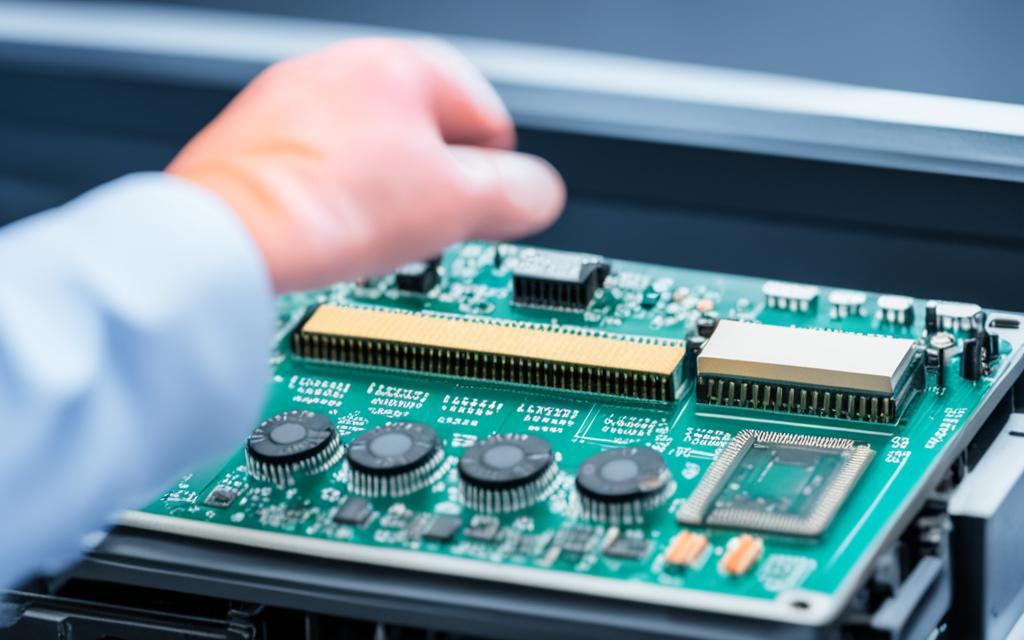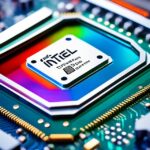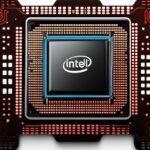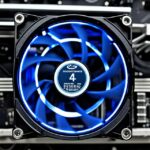Table of Contents
In the current era, where saving energy and keeping systems running longer matters, learning to downclock your CPU is key. This means you lower your processor’s speed and power needs. It can make your system more stable and may help it last longer. Our guide will show you the good and bad of this process. We aim to help you make smart choices about your system. Even basic processors, like the Intel Celeron N3060 that runs at a max speed of 1000 MHz, can be made more efficient by downclocking1.
Key Takeaways
- Understanding the basics of downclocking helps in enhancing CPU lifespan.
- Reducing voltage and frequency can lead to lower energy consumption.
- Improper downclocking may void warranties depending on the manufacturer.
- Backing up your system is crucial before making any adjustments.
- Stress testing post-downclocking ensures system stability.
- Utilising monitoring tools can help track temperature and performance changes.
Understanding CPU Downclocking
Many people look for ways to make their computers more efficient and last longer. Downclocking the CPU is one way to achieve this. It involves changing the CPU’s working settings. This method has benefits but also comes with risks that need to be understood.
What is Downclocking?
Downclocking a CPU means intentionally reducing its speed and power use. This leads to a drop in performance but can be done through BIOS or software changes. By cutting down the power, the CPU works efficiently without using too much energy. This helps improve the system’s overall efficiency2.
Benefits of Downclocking Your CPU
The benefits of downclocking are not just about changing how the CPU works. Key advantages include:
- It makes the system use less energy, especially when it’s not doing much3.
- It generates less heat, reducing strain on parts and helping them last longer3.
- It makes the computer quieter. Slower speeds mean fans don’t need to work as hard, which is great in quiet places3.
Potential Risks and Trade-offs of Downclocking
Despite its advantages, downclocking has its downsides. It could make the computer less reliable, especially for tasks that need a lot of power. You might notice slower speeds when accessing data. Also, some parts might wear out faster because of the changes made2.
If you’re keen on trying downclocking safely, there are detailed instructions that can help. They guide you through the process step-by-step.
Why Would You Want to Downclock Your CPU?
Downclocking your CPU brings many great benefits. These include improved performance and a lower environmental impact. It helps with saving energy, managing heat, and making your hardware last longer.
Improving Energy Efficiency
When you slow down the CPU’s clock speed and voltage, you save a lot of energy. This means you pay less for electricity and help the planet3. It also makes your computer run more efficiently in all tasks.
Reducing Heat Generation
Less heat comes out of your CPU when you downclock. This reduces stress on your computer’s parts. It’s great for silent places because low heat means you need less cooling4.
With controlled heat, cooling systems work better. This makes your computing experience quieter and more peaceful.
Extending the Lifespan of Computer Components
Downclocking can make your CPU and its parts last longer. It fights off the damage caused by too much heat. This is really good for old computers that get hot easily3.
This way, downclocking makes computing more sustainable. It helps your computer and the environment.
| Benefit | Impact on Hardware | Long-term Effects |
|---|---|---|
| Energy Savings | Reduces power consumption | Lower electricity bills |
| Heat Reduction | Minimises thermal stress | Prevents component overheating |
| Lifespan Extension | Enhances durability | Prolongs hardware life |
Preparing for the Downclocking Process
Starting the journey of CPU downclock preparation needs careful thought and detailed planning. The correct steps before changing your CPU settings protect your data. They also make your experience better.
Backing Up Your System
Before making any changes, a full system backup is vital. This action safeguards important files and data from loss during downclocking. You can use cloud storage or external drives for backup. By doing this, you can restore your system if anything goes wrong5.
Researching Your CPU Specifications
It’s important to know your CPU’s details. Understand its default frequencies and voltages. This info helps make the right modifications for downclocking. With this knowledge, you can change settings without affecting performance. You’ll manage a balance between efficiency and power needs6.
Understanding BIOS/UEFI Settings
Learning how to get into and understand your BIOS/UEFI settings is key. To enter these settings, you often use F2, Delete, or Esc when your system starts. Getting to know these settings, especially for CPU frequency and voltage, prepares you for downclocking6
How to Downclock Your CPU
Starting to downclock your CPU requires a careful and systematic approach. It’s all about making the right tweaks in the BIOS. This process consists of critical steps aimed at enhancing your CPU’s performance while keeping everything stable. Here are the essential steps to follow.
Accessing Your Computer’s BIOS/UEFI
To get into the BIOS settings, reboot your computer and press the F10 or Delete key. You can also access the BIOS through Windows’ advanced recovery options. This step is very important for modifying your BIOS settings1.
Identifying Frequency and Voltage Control Settings
Look for the CPU frequency and voltage control settings in the BIOS menu. These options can differ depending on the motherboard. You’ll probably need to look in the advanced settings area. It’s crucial to find these for adjusting the CPU voltage properly16.
Adjusting CPU Frequency and Voltage
After finding the settings, start to lower the CPU frequency and voltage little by little. Be careful to keep your system stable. Use the arrow keys or input fields for adjustments. Remember, small changes are best for system balance16.
Saving and Exiting BIOS/UEFI Settings
Once you’ve made your adjustments, don’t forget to save before exiting the BIOS. Do this by choosing the save and exit option. This makes sure your computer uses the new settings on the next reboot1.
Software Options for Downclocking
To downclock your CPU correctly, it’s essential to have the right software. You can choose from a few options, like Intel XTU and AMD Ryzen Master. These tools help you adjust the CPU settings directly from your Windows. They make it easy to manage your computer’s performance.
Using Intel XTU or AMD Ryzen Master
Intel XTU and AMD Ryzen Master are top picks for safely downclocking CPUs. These programs allow you to change speeds and voltages without the BIOS. That makes downclocking much simpler. They’re great for different types of processors, offering specific features for each. If you’re into making your system run more efficiently, these tools give you control over the settings.
How to Monitor Changes in Performance and Temperature
It’s crucial to watch the changes these software make. Intel XTU and AMD Ryzen Master have excellent monitoring options. They keep track of CPU temperature, power use, and overall performance after you’ve made adjustments. Monitoring helps prevent overheating or instability. By keeping an eye on these factors, your system stays safe and runs longer. For more tips on checking CPU temperature, check out
Testing Stability After Downclocking
After downclocking your CPU, it’s key to test everything thoroughly. This ensures the changes haven’t hurt your system’s stability or performance. Doing in-depth CPU stability testing is crucial. It shows how well the CPU handles different settings.
Running Stress Tests and Benchmarks
Stress tests should be done with top tools like OCCT, Prime95, and AIDA64. Aim for 8-10 hours. This long testing checks if your system stays stable under heavy loads. It tells you if the downclocking worked right7. Many find CPU problems come from wrong voltage settings after changes8.
Benchmarks then help spot any CPU performance dips after adjusting settings. They are a good way to double-check everything is working as it should.
Assessing System Performance Post-Adjustment
After these stress tests, look at how your system runs during normal tasks. Watch for any instability or slower performance. This helps decide if more tweaks are needed8. Keeping your system running nicely, even at lower speeds, is the goal.
Test results can vary a lot between different benchmarks, like Cinebench or Linpack Xtreme. This shows why using a variety of tests is good for a full evaluation9.
Maintaining Optimal Cooling and Performance
To get the best performance after downclocking your CPU, you need to adjust your cooling system. This means you might lower your fan speeds. This makes things quieter and saves energy too.
Adjusting Cooling Systems After Downclocking
With the right cooling setup, you can keep temperatures under control. Most CPUs stay safe and stable under 80-85 degrees Celsius10. Good cooling is key, even after you downclock. While many use air coolers, trying out liquid coolers or custom water cooling could push your performance even further10.
Balancing Performance Needs with Energy Savings
Finding a balance between strong performance and saving energy is crucial. Downclocking cuts CPU performance for heavy tasks but it also lowers heat and saves power11. For common tasks like surfing the web, you’ll see little difference. This lets you enjoy using less power without losing what you need from your PC. It’s important to keep checking your system to make sure you don’t hit any limits while trying to use less energy.
| Cooling Method | Cooling Efficiency | Noise Level | Cost |
|---|---|---|---|
| Air Cooler | Moderate | Low | Low |
| Liquid Cooler | High | Low to Moderate | Medium |
| Custom Water Cooling | Very High | Very Low | High |
By keeping these points in mind, users can keep their cooling optimal. They’ll also make the most of the energy savings and performance gains from downclocking11.
Conclusion
CPU downclocking is a smart way to save energy and make your computer last longer. By using a careful method, you can make your computer quieter and use less power. It’s important to prepare well and adjust things just right, or you might upset your system’s stability.
It’s also key to test your computer after making changes. This ensures it works as expected. Exploring downclocking opens your eyes to things that affect how well and efficient your computer runs. You can learn more about it here.
Choosing the right mix of speed and saving energy makes downclocking helpful. It’s great for those who want their systems to do more while using less. As we move forward, knowing how to manage computer power is getting more important121314.
FAQ
What exactly is downclocking a CPU?
Downclocking a CPU means reducing its speed and power use. This helps make the computer more efficient and stable. You do this through the BIOS or with software.
What benefits can I expect from downclocking my CPU?
By downclocking, you’ll use less energy and produce less heat. Your computer will run quieter. It may also last longer, especially if it’s an older model.
What are the potential risks associated with downclocking?
Downclocking might lower your computer’s speed in demanding apps. It could also lead to less stability. Changing these settings might void your warranty.
How can downclocking improve my computer’s energy efficiency?
Lowering your CPU’s speed cuts down on energy use. This can save you money and help the environment.
Will downclocking reduce heat generation?
Yes, it reduces the heat your computer makes. This means your cooling system doesn’t have to work as hard, making things quieter.
Can downclocking extend the lifespan of my computer components?
Definitely. It reduces heat stress, which can keep your CPU and other parts working longer. This is great for older computers.
Why is it important to back up my system before downclocking?
Backing up keeps your important files safe. This is crucial in case something goes wrong when you’re changing settings.
How can I research my CPU’s specifications to prepare for downclocking?
Knowing your CPU’s standard speeds and voltages is important. With this info, you can make changes safely without reducing performance.
How do I access my computer’s BIOS or UEFI for downclocking?
Reboot your computer and press keys like F2, Delete, or Esc to get into BIOS or UEFI. You might also find it in Windows’ advanced options.
What should I look for regarding frequency and voltage control in the BIOS?
Look for settings that control speed and power in the BIOS. You’ll likely find them under advanced settings.
How do I adjust my CPU frequency and voltage?
Once you find the right settings in the BIOS, use your keyboard to lower them. Make small changes to keep things stable.
What steps should I take to save my changes in the BIOS?
Don’t forget to save your changes and exit the BIOS correctly. This ensures your adjustments are applied when your computer restarts.
Are there software tools available for downclocking my CPU?
Yes, tools like Intel Extreme Tuning Utility and AMD Ryzen Master make it easy to change CPU settings in Windows.
How can I monitor the performance and temperature after downclocking?
Use software tools to keep an eye on temperature, power use, and performance after you’ve made adjustments.
Should I conduct any tests after downclocking to ensure stability?
Totally. Use stress testing software to check for stable performance. Also, benchmark tools can help you see how well your system is running.
How do I assess my system’s performance after downclocking?
Test your usual apps and tasks. Look for any slowdowns or issues. You might need to tweak your settings if you find problems.
How does downclocking affect cooling systems?
With less heat, you might be able to dial back on cooling. Still, keeping your system cool is very important.
How do I balance performance needs with energy savings when downclocking?
Find the right balance between saving energy and meeting your computing needs. Adjust your settings as necessary to get it right.
Source Links
- https://forums.linuxmint.com/viewtopic.php?t=365447 – how to underclock cpu – Linux Mint Forums
- https://medium.com/@guidesarena/step-by-step-instructions-for-underclocking-a-cpu-a2bacdf76746 – Step-by-Step Instructions For Underclocking A CPU
- https://www.lenovo.com/us/en/glossary/underclock/ – Efficiency Unlocked: The Underclocking Guide
- https://community.acer.com/en/discussion/514456/helios-300-windows-balanced-power-plan-cpu-doesnt-downclock-properly – Helios 300 Windows Balanced power plan, CPU doesnt downclock properly
- https://www.digitaltrends.com/computing/how-to-undervolt-cpu-guide/ – How to undervolt a CPU: Complete guide to undervolting | Digital Trends
- https://www.linkedin.com/advice/0/how-do-you-underclock-processor-skills-computer-hardware-lmpue – How do you underclock a processor?
- https://forums.tomshardware.com/threads/properly-stabilize-a-ryzen-cpu-overclock.3503530/ – How To – Properly Stabilize a Ryzen CPU Overclock
- http://www.vogons.org/viewtopic.php?t=28995 – CPU Overclocking, Underclocking and CPU Life & Heat \ VOGONS
- https://www.overclock.net/threads/what-is-a-quick-stability-test-to-run.1739000/ – What is a quick stability test to run?
- https://www.jawa.gg/blog/how-to-lower-cpu-temperature/ – How to Lower CPU Temperature
- https://www.linkedin.com/advice/3/how-does-underclocking-your-cpu-impact-computer-psddc – How does underclocking your CPU impact computer heat and performance?
- https://forums.tomshardware.com/threads/underclocking-for-lower-temps.1790565/ – Underclocking for lower temps.
- https://community.acer.com/en/discussion/594692/does-underclock-downclock-cpu-safe – Does Underclock/downclock CPU safe?
- https://softwareg.com.au/blogs/computer-hardware/cpu-not-downclocking-when-idle – CPU Not Downclocking When Idle








